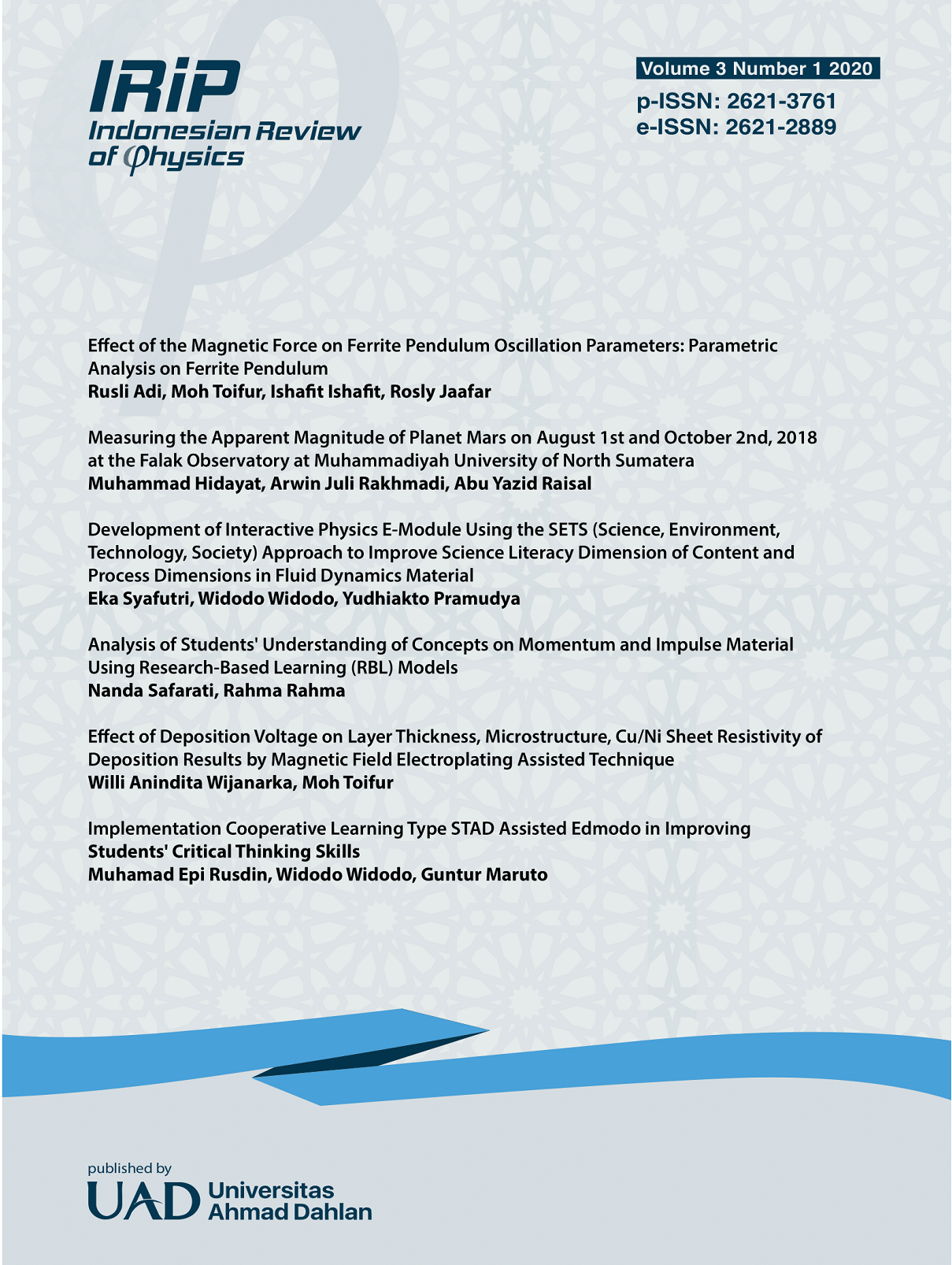Effect of Deposition Voltage on Layer Thickness, Microstructure, Cu/Ni Sheet Resistivity of Deposition Results by Magnetic Field Electroplating Assisted Technique
DOI:
https://doi.org/10.12928/irip.v3i1.1530Keywords:
Electroplating, Magnetic field, Sheet resistivityAbstract
The purpose of this research is to make the Cu/Ni thin layer as an alternative to basic RTD materials through electroplating methods assisted by magnetic fields. Electroplating was carried out with variation in deposition voltage ranging from 1 to 5 V. The results of this study indicate that the deposition voltage applied to the coating affects the thickness, sheet resistivity, and microstructure of the coating. Thickness increases with increasing deposition voltage. The diffraction intensity and crystal size tend to increase with increasing deposition voltage. The distance between Bragg planes after the coating is almost equal for all samples. The highest sheet resistivity was obtained in the coating sample with a 4-volt deposition voltage.
References
[2] T. Chowdhury and H. Bulbul, “Design of a Temperature Sensitive Voltage Regulator for AC Load Using RTD,†Int. J. Eng. Sci. Technol., vol. 2, no. 12, pp. 7896–7903, 2010.
[3] M. Toifur, Nuramalia A, Okimustava, and M. I. Sukarelawan, “Pengaruh Waktu Deposisi pada Tebal Lapisan, Struktur Mikro, Resistivitas Keping Lapisan Tipis Cu/Ni Hasil Deposisi dengan Teknik Elektroplating,†J. Mater. dan Energi Indones., vol. 7, no. 2, pp. 33–43, 2017.
[4] R. Fiqry and M. Toifur, “Pembuatan Lapisan Tipis Cu1/Ni1/Cu2/Ni2 sebagai Bahan Dasar Sensor Suhu Rendah dengan Metode Electroplating pada Variasi Tegangan Deposisi. UAD: Program Studi Magister Pendidikan Fisika,†UAD, 2018.
[5] P. Paridawati, “Analisa Besar Pengaruh Tegangan Listrik Terhadap Ketebalan Pelapisan Chrome Pada Pelat Baja Dengan Proses Electroplating,†J. Ilm. Tek. Mesin Unisma “45†Bekasi, vol. 1, no. 1, p. 97467, 2013.
[6] M. Ebadi, W. J. Basirun, and Y. Alias, “Influence of Magnetic Field on the Electrodeposition of Ni-Co Alloy,†J. Chem. Sci., vol. 122, no. 2, pp. 279–285, 2010, doi: 10.1007/s12039-010-0032-9.
[7] W. A. Wijanarka and M. Toifur, “Sintesis Lapisan Tipis Cu/Ni dengan Metode Elektroplating Berbantuan Medan Magnet pada Variasi Rapat Arus,†UAD, 2018.
[8] W. Giurlani et al., “Electroplating for Decorative Applications: Recent Trends in Research and Development,†Coatings, vol. 8, no. 8. 2018, doi: 10.3390/coatings8080260.
[9] S. Glasstone, “Introduction to Electrochemistry,†1962, doi: 10.1007/978-1-349-22721-1.
[10] N. Zaimah, A. Nurain, and S. Hussain, “Effects of Current Density on Size and Surface Morphology of High Speed Direct Nano-Crystalline Nickel Plating on Titanium Surface,†ARPN J. Eng. Appl. Sci., vol. 10, no. 17, pp. 7864–7869, 2015.
[11] S. B. Eadi, H. S. Song, H. D. Song, J. Oh, and H. D. Lee, “Nickel Film Deposition with Varying RF Power for the Reduction of Contact Resistance in NiSi,†Coatings, vol. 9, no. 6, 2019, doi: 10.3390/coatings9060365.
[12] M. Moradi-Haji Jafan, M.-R. Zamani-Meymian, R. Rahimi, and M. Rabbani, “The Effect of Solvents and the Thickness on Structural, Optical and Electrical Properties of ITO Thin Films Prepared by a Sol–Gel Spin-Coating Process,†J. Nanostructure Chem., vol. 4, no. 1, 2014, doi: 10.1007/s40097-014-0089-y.
[13] Y. Zhou, I. Matsubara, W. Shin, N. Izu, and N. Murayama, “Effect of Grain Size on Electric Resistivity and Thermopower of (Ca 2.6Bi0.4)Co4O9 Thin Films,†J. Appl. Phys., vol. 95, no. 2, pp. 625–628, 2004, doi: 10.1063/1.1631732.
[14] S. Sugianto et al., “Pengaruh Temperatur Annealing Pada Sifat Listrik Film Tipis Zinc Oksida Doping Aluminium Oksida,†J. MIPA, vol. 39, no. 2, pp. 115–122, 2016.
Downloads
Published
Issue
Section
License
Authors who publish in IRiP agree to the following terms: Authors retain copyright and grant the IRiP right of first publication with the work simultaneously licensed under a Creative Commons Attribution License (CC BY-SA 4.0) that allows others to share (copy and redistribute the material in any medium or format) and adapt (remix, transform, and build upon the material) the work for any purpose, even commercially with an acknowledgment of the work's authorship and initial publication in IRiP. Authors are able to enter into separate, additional contractual arrangements for the non-exclusive distribution of the journal's published version of the work (e.g., post it to an institutional repository or publish it in a book), with an acknowledgment of its initial publication in IRiP. Authors are permitted and encouraged to post their work online (e.g., in institutional repositories or on their website) prior to and during the submission process, as it can lead to productive exchanges, as well as earlier and greater citation of published work (See The Effect of Open Access).















